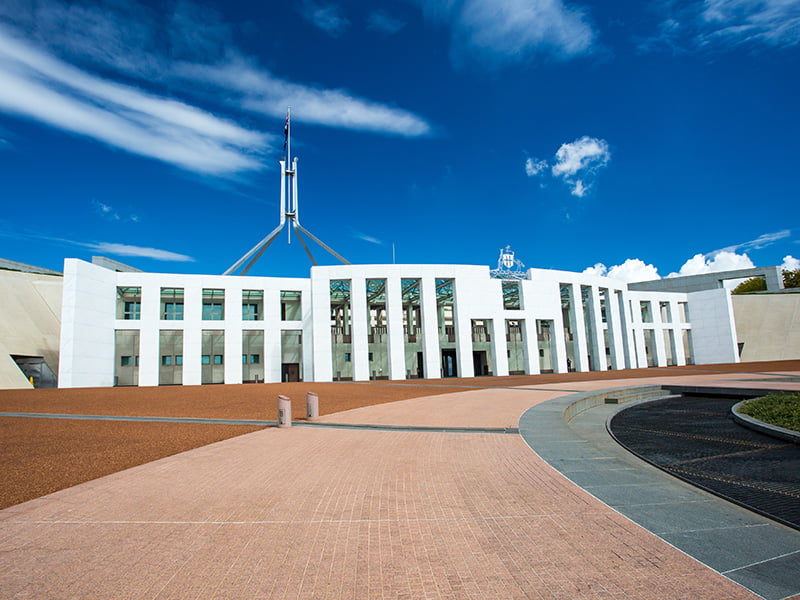Editorial: In years past, when you walked through the foyer and into the Department of Industry, Science, Energy and Resources you would pass large framed print photographs of the portfolio’s various ministers.
The photos always seemed outsized and over the top to me, but perhaps served a real purpose in making sure the omnipresent building security didn’t accidently bail-up the ‘boss’.
The joke, of course, is that Industry ministers have been replaced so frequently in recent years that the photo-portraits were indispensable.
In more recent times, the print photographs have been replaced with large portrait-style video monitors mounted on the walls displaying digital photographs of the various ministers.
The joke then became that the revolving door of ministers had accelerated to such a rate that efficiency demanded a move to digital.
Like the ministers, the portraits could be replaced with the press of a button. (I am sure there was an efficiency dividend in doing this.)
The point of this tedious anecdote is that the companies and institutions that make up the broad, horizontal Industry ecosystem crave stability.
To whichever side of politics forms government after Saturday’s federal election, we present a modest wish-list.

The first would be for a simplified portfolio in which a single senior Cabinet minister to lead the portfolio, and that this minister keeps the role for at least the duration of the next parliament.
The revolving door has got to stop. Since the Coalition was elected in 2013, there have been eight industry ministers (and nine if you include the split responsibilities of Angus Taylor and Melissa Price. Use two hand to count them: Macfarlane, Pyne, Hunt, Sinodinos, Cash, Andrews, Porter, Taylor/Price.
It is impossible for Industry to engage with government in a productive way in the face of this kind of constant change. Impossible.
It sends a terrible signal. It is extraordinary that the Industry portfolio has been treated as such an after-thought.
The Industry portfolio must be simplified. The instability that was caused by the conga line of ministers was entrench by the dog’s breakfast of a reshuffle that landed Angus Taylor as Minister for Industry and Minister for Energy and Emissions Reductions, while Melissa Price became Minister for Science and Technology and Minister for Defence Industry.
It is six months since the portfolio was cleaved in two and literally no-one knows for sure which minister does what.
Angus Taylor brought experience and expertise, but his plate was already full. The Industry portfolio is vast. It is incredible that he was appointed to the additional role on the eve of the Glasgow climate summit.
Even a big brain like Taylor could not hope to give it the attention it deserved.
And what to say about Melissa Price being given Science and Technology? You can make the argument that it’s a good thing to put it under the same minister as Defence Industry.
But Melissa Price’s first love was very clearly Defence Industry, and Science and Technology became very obviously a secondary consideration. That’s not good for anyone.
And how is it possible that Science is not under the same senior minister as Industry?
This trend toward weird portfolio complexity is not restricted to the Coalition. Labor made a similar pig’s ear of it when it reshuffled its front bench in January last year.
Ed Husic is shadow minister for Industry and Innovation. But what does that even mean when the centrepiece of Labor’s industrial policy – the $15 billion National Reconstruction Fund – sits under deputy leader Richard Marles?
Mr Marles is also shadow minister for Science. Again, how does this make any sense? Surely the Industry ministry must have responsibility for – among other things – the CSIRO?
The entire reason for CSIRO’s existence after all is to marshal science and research in the service of better industry outcomes for the nation.
Under Labor, the Industry minister will not have direct influence over CSIRO as an indispensable and invaluable national industrial asset.
The pandemic and the growing great power competition has put a spotlight on supply chains and sovereign capability like nothing else in the past 30 years.
These are serious times and Industry policy deserves a more serious discussion. It demands direct, sleeves-rolled-up leadership at the highest levels of whoever forms government in the coming days.
A high-performing Industry portfolio – and with it Science and Technology and Research – is key to Australia’s response to these significant national challenges.
Whoever forms government must put Industry at the centre of its policy agenda. It needs a senior Cabinet team driving its impact. And it needs stability.
And by the way, the idea that Industry policy doesn’t win elections, or that people don’t pay attention to these things is a nonsense. Industry is a central and foundational element of good economic policy.
A well-crafted and successful industry policy in a coordinating role with the other levers of government underpins business creation, new jobs, new wealth and a positive social impact for all Australians.
Have a great election day everyone.
Do you know more? Contact James Riley via Email.

